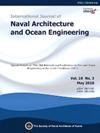Numerical simulations and large-scale experimental research into air-lifting system for deep-sea mining
IF 3.9
3区 工程技术
Q2 ENGINEERING, MARINE
International Journal of Naval Architecture and Ocean Engineering
Pub Date : 2025-01-01
DOI:10.1016/j.ijnaoe.2025.100656
引用次数: 0
Abstract
The deep seabed harbors abundant mineral resources. To achieve the economic viability of deep-sea mining, the efficiency of polymetallic nodule lifting is critical. In this study, we investigate the performance of air-lifting systems, which is a key component of deep-sea mining operations. Through two-phase flow simulations, we establish the relationship between the air-injection velocity and water-lifting velocity and validate the experimental data. We constructed a large-scale air-lifting system in a 20-m-deep water tank to explore the feasibility and energy efficiency of lifting water and nodules under varying air-injection velocities and depths. In detailed energy efficiency calculations, we determined the optimal operational parameters which provide novel insights into the design and optimization of deep-sea mining lifting systems. The experimental data and findings offer valuable references for future system designs that can enhance operational stability and economic feasibility.

深海采矿气举系统数值模拟与大型试验研究
深海海底蕴藏着丰富的矿产资源。为了实现深海采矿的经济可行性,多金属结核的提升效率至关重要。在本研究中,我们研究了空气提升系统的性能,这是深海采矿作业的关键组成部分。通过两相流模拟,建立了注气速度与提水速度的关系,并对实验数据进行了验证。我们在20m深的水箱中构建了大型气举系统,探索在不同的注气速度和深度下举升水和结核的可行性和能效。在详细的能源效率计算中,我们确定了最佳操作参数,为深海采矿提升系统的设计和优化提供了新的见解。实验数据和研究结果为今后系统的设计提供了有价值的参考,可以提高系统的运行稳定性和经济可行性。
本文章由计算机程序翻译,如有差异,请以英文原文为准。
求助全文
约1分钟内获得全文
求助全文
来源期刊

International Journal of Naval Architecture and Ocean Engineering
ENGINEERING, MARINE-
CiteScore
4.90
自引率
4.50%
发文量
62
审稿时长
12 months
期刊介绍:
International Journal of Naval Architecture and Ocean Engineering provides a forum for engineers and scientists from a wide range of disciplines to present and discuss various phenomena in the utilization and preservation of ocean environment. Without being limited by the traditional categorization, it is encouraged to present advanced technology development and scientific research, as long as they are aimed for more and better human engagement with ocean environment. Topics include, but not limited to: marine hydrodynamics; structural mechanics; marine propulsion system; design methodology & practice; production technology; system dynamics & control; marine equipment technology; materials science; underwater acoustics; ocean remote sensing; and information technology related to ship and marine systems; ocean energy systems; marine environmental engineering; maritime safety engineering; polar & arctic engineering; coastal & port engineering; subsea engineering; and specialized watercraft engineering.
 求助内容:
求助内容: 应助结果提醒方式:
应助结果提醒方式:


